#effective data visualization examples
Explore tagged Tumblr posts
Text
https://ezinsights.ai/effective-data-visualization-examples-and-techniques/
#effective data visualization examples#guide to data visualization#how to data visualization#types of data visualization techniques#why use data visualization tools#data visualization tips and tricks
0 notes
Text
Qualia and Ascension in Rain World
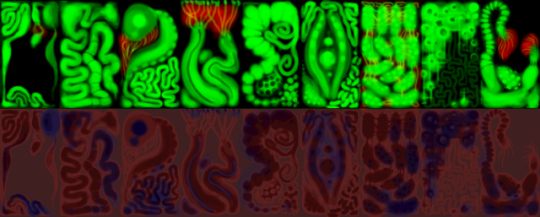
(To clarify I'm mostly talking about base-game lore and not including Downpour, but honestly most of these things can transfer over)
Qualia
One thing that’s relatively hidden in Rain World’s text and subtext is the concept of qualia. Qualia is described as being, “sensory experiences that have distinctive subjective qualities but lack any meaning or external reference to the objects or events that cause them.” It’s a personal sensory experience that cannot be comprehended by another person other than the individual themself, and are often hard to convey via language.
Qualia is a reoccurring motif in Rain World, but what’s more important is the way in which it’s conveyed to the player. The picture that’s painted is that of a world or civilization that placed a great importance on the individuals’ experience, and it’s shown through pearls or environmental details.
Here are some examples of qualia appearing in the text through pearls.
“It's qualia, or a moment - a very short one. Someone is holding a black stone, and twisting it slightly as they drag their finger across the rough surface. The entire sequence is shorter than a heartbeat, but the resolution is extraordinary.”
“A memory... but not really visual, or even concrete, in its character. It reminds of the feeling of a warm wind, but not the physical feeling but the... inner feeling. I don't think it has much utility unless you are doing some very fringe Regeneraist research.”
“This one... is authored by Five Pebbles, when he was young. There has been an attempt to scramble the data, but it's sloppily done, and most is still somewhat legible. It's written in internal language, or thoughts, so it is hard for me to translate so you would understand.”
But the most prominent examples of qualia and it’s importance in this world are the Memory Crypts and possibly ancient naming conventions. The deep purple pearl (shortened) found in Shaded Citadel states,
“In this vessel is the living memories of Seventeen Axes, Fifteen Spoked Wheel, of the House of Braids (…) Seventeen Axes, Fifteen Spoked Wheel nobly decided to ascend in the beginning of 1514.008, after graciously donating all (ALL!) earthly possessions to the local Iterator project (Unparalleled Innocence), and left these memories to be cherished by the carnal plane. The assorted memories and qualia include:”
Ancients likely mutated their own neural tissue into the cabinet beasts we see in Shaded, which were used to store their memories and qualia before ascension. Even james said once "how 5 pebs got the rot is a good hint here" in response to someone asking how cabinet beasts work, and how they're made.
Adding on to this, ancient (and iterator) naming conventions seem to be built off of the concept of qualia, with them focusing on individual images or experiences.
Nineteen Spades, Endless Reflections
Droplets upon Five Large Droplets
Two Sprouts, Twelve Brackets
Looks to the Moon
Generally, this all points to a world focused on the expression and preservation of the individual experience. You could even consider some of the echo dialogue as more evidence for this running motif, but I already have too many quotes lol.
Ascension
So now time to talk about my interpretation of ascension. In short, you turn into a worm, but I should probably explain more than that.
So its been surfacing on rw-tumblr that the light in the end of the game is called the egg in files. Although file names shouldn't be taken as fact or canon, it is pretty obvious given the birth imagery.
But something a little lesser known is what happens to the worm that takes us down to the void-sea depths. Void worms normally have a bright glowing effect, on their body, which is present for ours as well. But after it unhooks us, it swims down, and when it passes us on it's way back that glowing effect is gone.
To be honest, I don't really think this can be interpreted in many ways, but the most obvious one and the one I personally subscribe to is that the worm laid the egg. Biology and spirituality really aren't that different in Rain World, it's implied that karma is stored in the brain through Five Pebbles's slideshow. Adding on to that, we see voidspawn after eating an iterator neuron. One's spiritual state is innately tied to their mental state, and that dictates what and what they can't perceive.
And for that reason I decide to take a more biology leaning approach to what happens in the ending. At face value, we are fertilizing the egg of a void worm to be reborn into a voidspawn.
Not only do void spawn and void worms have multiple characteristics in common, (worm like bodies, tendrils/tentacles, glowing heads, void spawn look microbial and void worms are likely some of the oldest "life" in game)


but voidspawn are seen inside egg-like coverings and share the same egg light seen in the end of the game, confirmed to be the same thing by Videocult in a livestream they did.
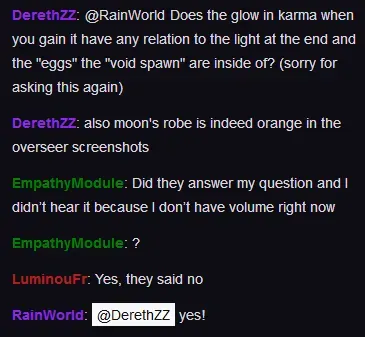
I believe that all this points to ascension being re-birth into a voidspawn, which eventually undergoes metamorphose into a worm. Higher-dimensional beings, who manifest and give birth to a new world.
So how does this tie in with qualia? Another thing you might know is that the area in which void spawn are most plentiful is Shaded Citadel and areas in Shoreline near Shaded. And shaded is absolutely packed with Cabinet Beasts, even outside Memory Crypts. I believe these qualia-storing creatures are what manifest voidspawn.
From what we see in ascension, it still looks physical and largely based around the real world. Hunter still has his scars and see's an iterator, survivor sees the slug tree in a more mystical and formless state, and monk sees survivor frankly just looking like a normal slugcat. I think that ascension is a product of qualia. We transcend our earthly knowledge via the egg, and our own qualia is used to give birth to a new world. This is why voidspawn appear most in Shaded Citadel.
Now I won't be getting into Void-Worm theories too much here, I'm mostly focused on ascension but I can't ignore the Gnosticism parallels. For those who don't know, Void Worms heavily resemble the Yaldaboath from Gnosticism, along with sharing some similar celestial motifs.

and running with that some people theorize that, like the Yaldabaoth, void worms are responsible for manifesting the material world. Ascension seems to be a mix of the concepts of Gnosis and Nirvana, but I believe it might lean more on Gnosis.
From my limited knowledge, Gnosis is a few things, some of which being a state achieved from experiences or intuitions, and an essential part to salvation is personal knowledge. While researching a bit, I came across this text by Peter Wilberg called "From NEW AGE to NEW GNOSIS" which brings up some comparisons between Gnosticism and qualia as well.
"Gnosis is subjective knowledge of an inner universe made up not of matter, energy, space or time but of countless qualitative spheres or ‘planes’ of awareness – a knowledge obtained directly through inter- subjective resonance. It is the subjective science of this inner universe."
One thing though that has been brought up when discussing this is how this can be consolidated with the tone of the ending. It is pretty un-ambiguously happy, but if we're going with the Void worm Yaldaboath theory then that would put a bit of a sour twist on it right?
I agreed with these for some time, but now I actually think it ties in perfectly with Rain World's core themes as stated by the devs, "overcoming differences and finding empathy." I don't think the void worms are "evil" or malevolent, but I think they (and subsequently us after ascending) play a key role in demonstrating this theme.
By manifesting the physical world, we allow these souls to experience life and develop their own qualia so one day they can ascend themselves. We are shown compassion, and pass it forward.
782 notes
·
View notes
Note
"I could explain more about the Laplace Demon concept if you, dear readers, are interested but that would be for another occasion. Another essay hehe."
Pleasepleasepleasepleasepleasepleasepleasepleasepleasepleasepleasepleasepleasepleasepleasepleasepleasepleasepleasepleasepleasepleasepleasepleasepleasepleasepleasepleasepleasepleasepleasepleasepleasepleasepleasepleasepleasepleasepleasepleasepleasepleasepleasepleasepleasepleasepleasepleasepleasepleasepleasepleasepleasepleasepleasepleasepleasepleasepleasepleaseplease 🛐
Explaining Laplace's Demon tehory in the context of 14dwy.
Thank you so much for giving me an excuse to talk about this dear anon!
In this post i'll elaborate further about something i said in the end of this super long post. As always TW for 14dwy spoilers!
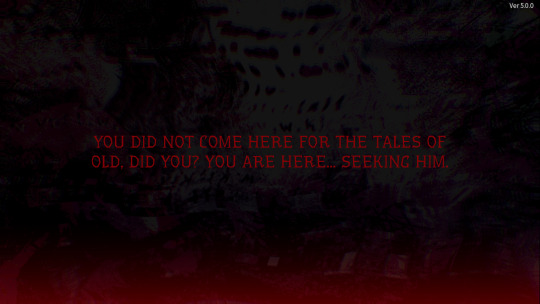
(Joke's on you, sir, i DID come here for the tales of old)
And this tale in specific is really old. Around two hundred years old to be specific. In 1814 a man known by the name Pierre-Simon de Laplace wrote an essay about a deterministic concept known later as the "Laplace's demon" (although he already seemed to be exploring this concept since 1773)
We may regard the present state of the universe as the effect of its past and the cause of its future. An intellect which at a certain moment would know all forces that set nature in motion, and all positions of all items of which nature is composed, if this intellect were also vast enough to submit these data to analysis, it would embrace in a single formula the movements of the greatest bodies of the universe and those of the tiniest atom; for such an intellect nothing would be uncertain and the future just like the past could be present before its eyes.
(Pierre Simon Laplace, Philosophical Essay on Probabilities.)
But what does this all mean? Well basically this man spoke about a hypothetical "intelligence" (he didn't precisely used the word "demon") that, knowing the precise location of every particle in the universe and where they were headed, they would be able to guess the past and future values for any given time. In other words, we would be referring to an almighty hypothetical "thing" able to see the past and future of every single thing in the universe.
Of course this is all a model, a theory, an exploration on what would happen if something like this existed in the first place. After all, it was all a philosophical essay in the first place, wasn't it?
"Une intelligence ... Rien ne serait incertain pour elle, et l'avenir, comme le passé, serait présent à ses yeux."
Of course, Mr. Laplace wasn't the only one to explore the idea of an almighty intelligence since other philosophers like Condorcet, Holbach and Diderot also wrote about it.
Now there are several theories (some more modern than others) to explain why an intelligence of this nature will never be possible to exist but there is one that might ring a bell for some people "The Chaos Theory"
Or as some might know it: The butterfly effect.
This theory basically poses that minor variations between the starting conditions of two systems can result in major differences. That's why you say that "A butterfly flying in certain direction today can lead to huge catastrophes tomorrow" it's not something (so) literal but it is useful to illustrate how small can be the variation and how huge can be the result. Of course the change doesn't have to be huge. It can be a minor change, but a change nonetheless.
Btw chaos theory is applicable when knowledge of the system is imperfect, whereas Laplace's demon assumes perfect knowledge of the system, therefore the variability leading to chaos in chaos theory and non-variability in the knowledge of the world Laplace's demon holds are noncomparable.
But, What does this all has to do with 14dwy?
Glad you ask. Actually a lot.
Starting off with the idea of how perfect is this game integrating even its genre (Visual Novel) to the theory. I believe there is no bigger example of the butterfly efect than a Visual Novel, where choosing (or not) certain options can lead to certain results (big or small). Very much like the butterfly effect. And funnily enough, it's us, the player, the embodiment of this umpredictability, since we are the ones that make the choices in the game. We are the antagonists of a hypothetical Laplace's Demon. We are it's antonym. We are an angel. The idea of a change that the system cannot predict. Of course this is questionable. Because as much as we have certain "freedom" we still need to abide by the choices that the very game gives to us.
This takes us back to the question of who is the entity that speaks to us in this cryptic messages on day four? Who is this (allegedly) Laplace's Demon? and what are my personal arguments on why i don't think it's [REDACTED].
Let's start by breaking down the messages. I have them all decoded in my previous post along with a really easy (i hope so) explanation on how the cipher works.
"...ATTEMPTING TO REWRITE WHAT HAS ALREADY BEEN ORDAINED SINCE THE BEGINNING"
Here, the entity mentions the certainty of the past, but not the certainty of the future.
"...ATTEMPTING TO DIG UP THE ROOTS OF FATE AS THOUGH IT WERE A WEED AND PLANTING YOUR OWN CORRUPT SEEDLING IN ITS PLACE"
Here, the entity presumably refers to the idea of our (very limited) free will and how we're pushing the limits of the system (in this case by attempting to keep advancing on a route that supposedly leads nowhere else). To make this more clear, this entity speaks to us when we load the save file multiple times trying to keep advancing down that path when the course of action contemplated is that we should just stop and load another save file. We're persistent creatures, after all.
"PERHAPS WE ARE THE SAME, THEN"
Of course fucking ✨not✨
"I TOO FIND ENJOYMENT IN DISRUPTING THE VINES OF KISMET AND WATCHING HIM STRUGGLE"
Now i swear i never heard the word "kismet" before this day. But it seems to be some sort of archaic synonim of the word "fate". Although according to Cambridge Dictionary it is actually "A force that (some people) think controls what happens in the future, and is outside human control"
Also, this entity seems to be having its fun with Ren/REDACTED's struggles. It doesn't really see our unpredictability (yet) as a threat.
"TWAS I WHO GAVE HIM HIS GIFT, AS I DID WITH OTHERS..."
AND THIS
This right here boy oh boy.
I gave him his gift: A rant about human deities through the holy act of programming.
(As pretentious as this title is, please hear me out)
There's a really interesting article named Embracing Λόγος: Programming as Imitation of the Divine that basically says:
The programmer must begin by defining things – material or conceptual. “We are unable to reason or communicate effectively if we do not first make the effort to know what each thing is.” (Rayside, Campbell) By considering the ontological questions of the things in our world, in order to represent them accurately (and therefore ethically) in our programs, the programmer enters into the philosophical praxis. Next, the programmer adds layers of identity and logic on top of their ontological discovery, continuing in the praxis.
But the programmer takes it a step further – the outcome of their investigation is not only their immaterial thought but, in executing the program, the manifestation of their philosophical endeavor into material reality. The program choreographs trillions of elementary charges through a crystalline maze, harnessing the virtually infinite charge of the Earth, incinerating the remains of starlight-fueled ancient beings in order to realize the reasoning of its programmer. Here the affair enters into the realm of Ethics.
“The programmer is attempting to solve a practical problem by instructing a computer to act in a particular fashion. This requires moving from the indicative to the imperative: from can or may to should. For a philosopher in the tradition, this move from the indicative to the imperative is the domain of moral science.” (Rayside, Campbell) Any actions taken by the program are the direct ethical responsibility of the programmer.
Furthermore, the programmer, as the source of reason and will driving a program, manifesting it into existence, becomes in that instant the λόγος σπερματικός (“logos spermatikos”) incarnate. The programmer’s reason, tapped into the divine Reason (λόγος), is generated into existence in the Universe and commands reasonable actions of inanimate matter.
Basically the programmer goes through each and every stage a deity would go through when creating the universe.
AND GUESS WHO IS A PROGRAMMER IN 14DWY???
(Ren/REDACTED in case you don't know hehe)
When the entity says "I gave him his gift" i believe this is exactly what he is referring to. While a Laplace's Demon knows every particle in the physical systems (and assumes it's knowledge of said system is perfect), a programmer works with Operative Systems (Windows, Linux, Ubuntu).
As for us, the angel, the antagonist of the demon of Laplace, we are the chaos theory, the one that conceives the knowledge of the system as imperfect.
Btw the person manipulating some choices in certain moments? Totally Ren/REDACTED. As they have the power of messing with the game and are totally self-aware of this being a visual novel.

But who gave Ren/REDACTED this power? Was Ren/REDACTED so skillful that they were able to defy the laws of worldbuilding? Picture this: the equivalent would be a programmer in the real world so skillful that they become able to defy the reality itself.
I believe the responsible is this "all knowing entity" since it just said it itself "It was I who gave him his gift". After all he is, and i quote, "THE PAST, PRESENT, AND FUTURE, COMBINED INTO ONE" really ominous shit.
There are obvious gaps in this theory but it's the best i can do with the limited knowledge i have. I am not a physicist so i can't really dwell in formulas and numbers as much as i would. Maybe i'll interview a professor in college in the future but for now i hope this is enough.
#14dwy analysis#14dwy#14 days with you#i really hope cutiesai sees this omg#14dwy ren#14dwy redacted
119 notes
·
View notes
Text
Another scene in The Measure of A Man I want to touch on is the scene in the Observation Lounge, in which Maddox explains his plans for Data to Picard and Riker. First and foremost, we need to talk about the seating arrangment; how and where each character sits around the table.
Picard, of course, sits at the head of the table. Riker sits to Picard's right, Maddox sits to Picard's left (across from Riker), and Data sits left of Maddox.
By sitting in this manner, Maddox can talk to Picard and Riker while literally turning his back on Data, thereby not only verbally excluding him from the conversation (by not addressing him at all until forced to, and, one could argue, by calling him "it", although that's a bit more nuanced) but also literally blocking Data from joining the conversation with his body. Maddox sits leaned forward, which means Picard must lean sideways to even be able to see Data behind Maddox, which we can see him do.
And this seating arrangement is important!! It is a beautiful piece of visual storytelling; it shows precisely what the dynamic between Maddox and Data is and adds to the verbal cues we get.
But there's so much moreeee!
Like I said, Maddox doesn't actually address Data until Data asks him if he's constructed a positronic brain. He looks to Data with full confidence-- even a degree of smugness-- and confirms that he has. When Data bombards him with (VALID ASF) questions about how he'll work around certain issues, Maddox averts his gaze, only looking at Data sporadically, until he doesn't look at him anymore at all. Then he turns fully to Picard and Riker when he says: "I do not anticipate any problems", a sense of finality to his tone. It effectively stops Data from asking further questions.
Fortunately, Riker and Picard aren't convinced either, and here is where the dynamic of the scene shifts. Instead of Maddox's intended triangle of himself, Picard and Riker with Data on the outside, it now seems more like he sits surrounded; trapped between Picard, Riker and Data as they each ask him critical questions. We can physically see the shift in Maddox's body language-- he ducks his head, shifts around and makes himself look smaller. It's clear he now feels intimidated. Backed in a corner and with Picard telling him he won't allow Data to submit to the tests, he finally pulls out the transfer orders.
This scene is SO POWERFUL in how it visually sets up the dynamics between each of these characters, and how Maddox physically disrupts the pre-existing dynamic. It's a prime example of how the placement of characters and camera work can be used to tell a whole story without words. Idk who was in charge of this creative decision, but they deserve a standing ovation OMGGG
Again, I have the scene here-- it's zoomed and sped up but it's the only one I could find. I cut it off after Picard tells Maddox no, but immediately after that he pulls out the transfer orders and the scene ends.
#there's even more details to talk about honestly#like Data's tense body language for example#and how he and Riker glance at each other while Maddox talks#Riker is a real one because he also watched Maddox like a hawk while bro was leering at Data on the Bridge earlier#anyways I see why ppl ship them now lmao#star trek the next generation#star trek tng#tng#data soong#brent spiner#will riker#jonathan frakes#is their shipname really#daiker
42 notes
·
View notes
Text
Oh, also, I really hope that this point isn't news to anyone, but if you don't already have a basic understanding of what it means to develop information security, now is the fucking time.
Critically, I want to see people being responsible in how they interact with:
A) the dissemination of information and the correction or disruption of misinformation
B) privacy related or personal data (of themselves, but ESPECIALLY of others who you could unknowingly harm)
C) pictures and visual media
D) your bodies: not a good time to start leaving traces of yourself where they shouldn't be, e.g. blood, saliva, etc
E) triangulatory/tangential information (you know that guy who can tell where you are by the weather descriptions? That's an extreme example very few people can pull off, but you'd be horrified how little info I need about someone to correctly interpret whole sections of their personal history and data)
F) other people. If you have never formally done so, find a conflict resolution/group facilitation class with a local organizing group or community college. Start learning what healthy boundaries (flexible, but neither porous nor rigid) look like for you. Pick a communication style to cultivate so you can be consistent in how you navigate stressful moments. Figure out what it means to you to share space with others with intention. (And yes, there is no one way to do this, but every one of us will need to find our most secure version, whatever that is, ESPECIALLY those of us who are already vulnerable here due to past trauma, neurotype, TBI, healthcare/wellbeing needs, etc)
I'm a really open book in a lot of ways, and yall might rightly look at that and go "butts you're one to talk about infosec"
And yeah. Yeah. But like.
I know what you know. I made those choices on purpose or at the very least addressed the aftermath of the accidents with intention. I also know what I did to be protective of myself and my info, and you don't know those things. You should know how to do them for yourself though, because it will help you understand why I can have done what I've done over the years and still say this now.
It matters what people know. It matters how easy that knowledge is to revisit. It matters how much of that knowledge is heresay vs documented and verifiable. It matters what contrary information is ALSO known. It matters what interconnected information about OTHER PEOPLE is known. It matters when you haven't said anything at all versus when you said a bit versus when you said a LOT. It matters when you say a lot without saying anything at all.
Information gathering is about putting together puzzle pieces. It's slow work, and it involves a massive amount of resources to do comprehensively and at scale. Information security is about making the gathering process not worth the investment such that the gatherers give up before they are able to put together enough pieces to do real damage. This is what "need to know" means.
For example, in a healthcare practice, it is a HIPAA requirement that access to protected patient info be limited to those who have a clinically relevant reason for accessing it. This means that certain system credentials or permissions will reveal varying amounts of protected information about a person. While one MIGHT be able to put together enough puzzle pieces for certain minor information gathering from early stages (e.g. where someone will be a the specific time of their appt), one likely cannot identify deeper and more vulnerable levels of information (who is the appt with and what is it for?)
This kind of layered buffer is most important when people who AREN'T PERMITTED (permited as in able to do without effective correction/consequence, not permitted as in legally or appropriately authorized to do) to access this info are trying to access it. If someone is permitted (e.g. if person with the appropriate credentials/access permission discloses it voluntarily or if a subpoena is ordered, etc) then the level of access is less protective - they will typically simply access the level of info they need if they will be permitted to.
But there are further layers still of information security. For example, you can tie up a LOT of time forcing authorized bodies to refresh and specify their authorization over and over again, each time appropriately only providing the exact level of disclosure they have required of you. The more specific the information they are looking for, the easier it is to bury so deep down that they literally cannot access it even if they are looking right at it.
I was taught to write documentation "like at any time it could be read out by the patient in front of you, or by another provider asking us to justify a treatment, or in open court by order of a judge". For a year, my supervisor had me write four copies of every piece of documentation I ever made. My personal copy (burned upon completion of the billable note), my "soft note" that removed all protected/identifiable information from the narrative (e.g. names, ages, genders, specific diagnoses/conditions), my "hardnote" which removed anything "heresay" which had been self-reported by the patient unless I could professionally verify it), and lastly my billable note which I understood needed to offer "detailed justificstion" for the used (and named) interventions which cannot be used to work backwards and interpret the originating care conversation.
The only note that ever gets read by anyone but myself is the billable, because they others are never retained long enough to be seen by others, even if they do have the appropriate access. It becomes very difficult for someone to use the hard data they are capable of getting from me, voluntarily or by force, to actually confirm context. This is a similar principle when orhanizers compartmentalize need-to-information.
So start learning what it looks like to cordon off each layer of infosec you're about to implement in your life. What it will look like to grant someone access to a new layer.
Be responsible. We protect us.
#man i really hope i actually managed to make clear what i'm trying to say here#dogwhistles are hard when your workbook comes from three generations back lol
78 notes
·
View notes
Text
Here's the actually* short notes for the course, "The Science of Well-Being" from Yale on coursera, which is available for free. Mostly focusing on the actionable steps.
Point the first: We/society at large is often wrong about what makes people happy/have a sense of well being. Unless you've been reading into motivation, happiness, flow, etc, already, in which case you're likely right on track.
We adapt to both good things and bad things, so neither one effects us as much as we think they will. Our brains adapt to, and filter out stimuli after a while. If we want to get the most enjoyment out of something/life, we should increase variety and take breaks. Like, drink a different kind of tea every day, or take breaks when listening to music. Also, practicing gratitude, savoring (pausing and intentionally appreciating the good moments in life), sharing experiences with others, and recalling past moments of joy. Also, you can practice negative visualization, when you on purpose think of how awful the world would be if you didn't have something that you do have.
A good job is one that allows you to practice your signature strengths and enter the flow state.
The income-increased happiness plateau is somewhere between $75k and $500k- but I found a recent article** after the comments to this effect, and "Yet is important to note that the relationship is weak, even if statistically robust. The correlation between average happiness and log(income) is 0.09 in the experience sampling data, for example, and the difference between the medians of happiness at household incomes of $15,000 and $250,000 is about five points on a 100-point scale. The flattening and accelerating patterns are even smaller modulations of a small effect. However, the emotional effects of other circumstances are also small. KD reported that the effect of an approximately four-fold difference in income is about equal to the effect of being a caregiver, twice as large as the effect of being married, about equal to the effect of a weekend, and less than a third as large as the effect of a headache." Which says to me I'm making the right move by going to a 4 day work week :P But seriously, that's great news.
We think in comparisons, and comparison is the thief of joy. You can reduce consumption of images of people who are richer, cooler, more skilled, etc than you, and that will help prevent mood deterioration. You can also reframe to compare to yourself in the past.
Being kind makes you and everyone involved happier. Buying things for others makes you happier than buying things for yourself. Giving to charity makes you happier if it builds social connection. (Why the focus on buying things to make you happier? Why not on actions you can take to make yourself or someone else happier? Probably because giving someone $20 is easier from a study's standpoint.)
Get 7 or more hours of sleep a day.
Move 30 minutes a day.
Meditate- look into mindfulness, loving kindness.
Social connection- doesn't have to be a romantic relationship! Just interacting with others, even strangers, makes us happier (still sounds fake to me, but I'm like a mega introvert). Spending time with people you like is good.
Having free time is important.
Create an environment that supports what ever change you're trying to make.
WOOP = Wish, Outcome, Obstacles, and Plan. "What's your wish for your goal? What's your best outcome? What are the obstacles? What's your if-then plan?" Really helps with actually accomplishing your goals.
*I realized I said short notes before, but then somehow that ended up being super long.
** Income and emotional well-being: A conflict resolved by Matthew A. Killingswortha, Daniel Kahnemanb, and Barbara Mellers
207 notes
·
View notes
Text
Even like my whole thing about the Vimalakirti Sutra and Urapic vol. 8 is that like. The whole point of the Vimalakirti Sutra illustrated by that famous episode about the discussion of nonduality (and in general very foundational in Mahayana Buddhism) is that as mortal beings we don't have access to the Real. We only have access to Phenomena, and these phenomena have fundamentally unquantified and unquantifiable relationship to the real. An example that they didn't know back then but is a good example of this is that due to the camera obscura effect, the light that enters our eyes actually comes in flipped relative to what's actually out there in the world; that is our eyes perceive the world as being upside-down, and our subconscious mind processes that raw visual data such that we perceive everything as being the right side up. So when we're beings with senses so fundamentally unreliable, when our experience of the world is so fundamentally subjective, how can we, in a purely intellectual context, be sure of the relationship between the Names we apply to the phenomenological objects of our experiential world, and the Real objects in the Real World, our experience of which is entirely and fundamentally mediated?
There are more answers to this question as there are grains of sand in the Ganges, of course, but because of this consideration it is obvious in a lot of ~eastern philosophy~ (not a fan of the term but whatever). That to Name is Not Neutral. To name is not to describe reality, to name is to Create and Establish a specific phenomenological reality. To apply a name to something is always to make a Specific and Non-Neutral Rhetorical Claim both about the Thing which you have named and, arguably far more crucially, everything which is Not what you have named.
35 notes
·
View notes
Note
https://twitter.com/ZakugaMignon/status/1739703106466627976?t=6BRheBvMK4MlCt5gXaj4ig&s=19
this is a comically misleading graph lol (copy-pasted it below)
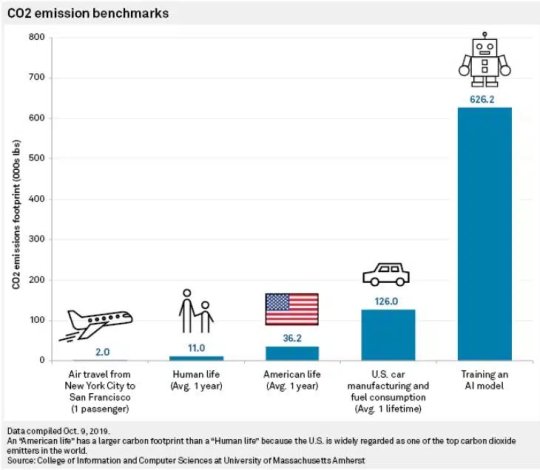
like you look at this and obviously think 'wow training an AI model is so much more carbon-intensive than planes or cars' -- but if you look at the actual units being chosen, they're fucking stupid. like, why is the air travel one the only one measured per passenger? the AI model will presumably be used by more than one person. fuck, even the average car will often be transporting more than one person! why is the car the only one that has its lifetime use and manufacturing cost combined when the AI model only has its manufacturing cost and the plane only has the cost of a single flight divided per passenger?
these are absolutely fucking nonsensical things to compare, and obviously chosen in ways that make AI look disproportionately bad (and air travel look disproportionately good, for some reason?). i'm not even touching the profoundly Fucked political implications of measuring the CEO emissions of 'a human life'
but let's, just for funsies, assume that these are reasonable points of comparison -- in 2021, 9 million cars were made in the USA. for the environmental impact of training AI to be even equal to the effects that those cars will have over their lifetimes (which this graph obviously seeks to imply), there would have to be over a million AI models trained in that time. which--hey, hang on a minute, that reminds me, what the fuck is 'training an AI model'! AI models come in all kinds of sizes -- i don't think the machine learning model that the spiderverse animators used to put the outlines on miles' face cost as much to train as, say, DALL-E 3! there is no indicator that this is an 'average' AI model, or whether this is on the low or high end of the scale.
so having just had that above question, i went to look at the original study and lol, lmao even:
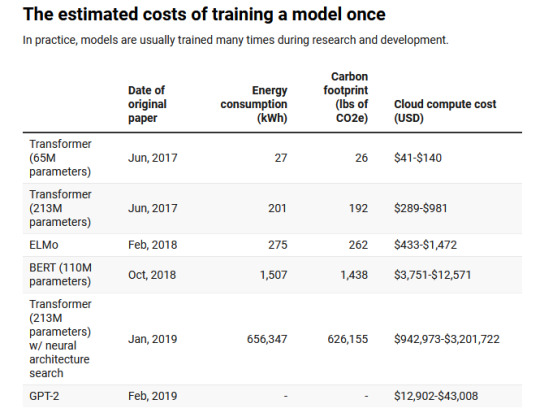
the 626,000 lbs figure is actually just the cost of that one specific model, and of course the most expensive in the study. there's no convincing evidence that this is a reasonable benchmark for most AI training -- for all this study's extremely limited set of examples tells us, this could be an enormous outlier in either direction!
so yeah, this is officially Bad Data Visualization, & if you originally saw this and thought "oh, it looks like AI art really has a huge environmental impact!" then, like, you're not stupid -- the person making this chart obviously wanted you to think that -- but i recommend taking some time when you look at a chart like this to ask questions like 'how was this data obtained?' and 'are these things it makes sense to compare on the same scale?', because there's a lot of misleading charts out there, both purposefully and through sheer incompetence.
372 notes
·
View notes
Text

SEO for YouTube: How to Optimize Your Videos for Search
Meet Paul. Paul is a budding YouTuber with a passion for tech reviews and tutorials. He’s been creating content for a while, but his channel isn’t growing as quickly as he’d hoped. Paul’s videos are high-quality, informative, and engaging, yet they’re not reaching a wide audience. The key problem? His videos are not optimized for YouTube’s search algorithm. This is where SEO, or Search Engine Optimization, comes into play.
Understanding YouTube SEO
SEO for YouTube involves optimizing your videos so they rank higher in search results. Higher ranking videos get more views, which can lead to more subscribers and overall channel growth. Here’s how Paul can optimize his videos for YouTube search:
Keyword Research
Paul’s first step is to find the right keywords. Keywords are the terms and phrases that users type into the search bar when looking for videos. Paul uses tools like Google Trends, TubeBuddy, and VidIQ to identify popular keywords related to his content. For instance, if Paul’s video is about the latest iPhone review, he might discover that “iPhone 14 review,” “iPhone 14 unboxing,” and “iPhone 14 vs Samsung Galaxy S22” are popular search terms.
Optimizing Video Titles
Once Paul has his keywords, he needs to incorporate them into his video titles. A good title is clear, concise, and includes the main keyword. For example, instead of titling his video “My Thoughts on the New iPhone,” Paul titles it “iPhone 14 Review: In-Depth Look at Apple’s Latest Smartphone.” This title is more likely to match what users are searching for.
Creating Engaging Thumbnails
Thumbnails are the first thing viewers see. An eye-catching thumbnail can significantly increase click-through rates. Paul creates custom thumbnails that are visually appealing and relevant to the video content. He includes the video title or key phrases in the thumbnail to attract viewers’ attention.
Writing Detailed Descriptions
The video description is another crucial SEO element. Paul writes detailed descriptions for his videos, incorporating his main keyword and related terms naturally. He includes a brief summary of the video, timestamps for different sections, and links to his social media, website, and other relevant videos. This not only helps with SEO but also provides a better viewer experience.
Using Tags Effectively
Tags help YouTube understand the content of a video. Paul uses a mix of broad and specific tags, including his main keyword and variations of it. For his iPhone review video, he might use tags like “iPhone 14,” “iPhone review,” “Apple smartphone review,” and “tech reviews 2023.”
Engaging with Viewers
Engagement metrics like likes, comments, and watch time also influence search rankings. Paul makes an effort to engage with his audience by asking questions in his videos, responding to comments, and encouraging viewers to like and share his videos. The more engagement his videos get, the higher they are likely to rank.
Promoting Videos on Social Media
Paul doesn’t rely solely on YouTube’s search algorithm to drive traffic. He promotes his videos on social media platforms like Twitter, Facebook, and Instagram. By sharing his videos with a broader audience, he increases the chances of getting more views and engagement.
Analyzing and Adjusting
Finally, Paul regularly reviews his analytics to understand what’s working and what’s not. He looks at metrics like watch time, click-through rates, and viewer retention. Based on this data, Paul adjusts his SEO strategy and content approach to continually improve his channel’s performance.
Conclusion
Through consistent effort and strategic optimization, Paul starts to see his videos rank higher in YouTube search results. His channel grows steadily, attracting more viewers and subscribers. By following these SEO practices, Paul not only improves his search rankings but also enhances the overall quality and reach of his content.
For any YouTuber looking to grow their channel, understanding and implementing YouTube SEO is crucial. Just like Paul, you too can optimize your videos and achieve greater success on the platform.
60 notes
·
View notes
Text
Random thought that just hit me, but do you ever wonder if--during Mata Nui's travels to other worlds--he might’ve taken inspiration from the things he's seen and tried to incorporate them into the little universe inside him?
For example, let's say that Spherus Magna never experienced an Aurora Borealis. Since Mata Nui's systems control the environment and the effects in the sky, that means there wouldn't be a light show happening in the coldest places like Ko-Metru or even on the fake island disguise. All seems normal for him as he's hiding and observing the locals on a planet as usual.
Suddenly, he sees an Aurora that's so captivating that he can't help but marvel at such a natural phenomenon (even if it winds up somewhat messing with the electronic devices/systems he has). Since it's his mission to study other worlds and report back to the Great Beings, why wouldn't he want to show them such a discovery? Why wouldn't he want to share the phenomenon with his inhabitants by adding it to his system's network data to recreate the visual effects just like the stars in the sky?
Cue everyone who lives in or near freezing cold places (like the Shadowed One's species) at high altitudes freaking out when they see a rainbow of wiggly lights in the air the first time it happens and wondering what this means 😂
I dunno, it just seems like if I were a several million foot tall robot who could control an entire universe (including the stars), why wouldn't I want to incorporate something visually stunning into said universe? He created the Makuta, so what's stopping him there? :V
#bionicle#matoran universe#mata nui#I love beautiful natural phenomenon and dangit I wanna imagine the Matoran Universe experiencing such joy too!
60 notes
·
View notes
Text
Okay!
First of all: I am very sorry it took so long to finish this! It had been a lot more data than last time, so I had some trouble to visualize and edit it this time around. I really hope I made it work somehow so enjoy this lil conclusion thingy and feel free to add or mention anything that comes to your mind~
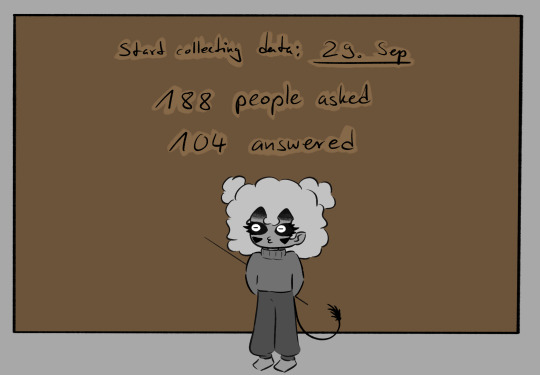
In this survey I have asked a total of 188 people multiple questions surrounding sleep habits, their consume of caffein and its influence on them and got an answer from 104 of these.
So let’s beginning with the average hours per sleep these people had.
Well, as we saw in the last survey I did, most people I have asked didn’t had a good sleep schedule. The average hours that a rottmnt tumblr artist out of 104 get is 6,48 hours per night.
I tried my best to categorize the hours into 1-3; 4-6; 6-7; 7-9; 10+ h/night. The most common one being 4-6 h/night and 7-9 h/night which is a little surprising remembering that only 18% of people of my last survey actually have a “good”-sleep schedule in hindsight that the recommended amount of sleep is 7-9 hours/night.
These numbers could be explained that for a lot of people the amount of hours they sleep depends on factors like if they´re having a stressful time at the moment or how much they did over the day so the numbers itself varied often from 3-8 hours. Of course, no one sleeps the exact amount of hours every single time so the range a lot people mentioned had been partly very big.
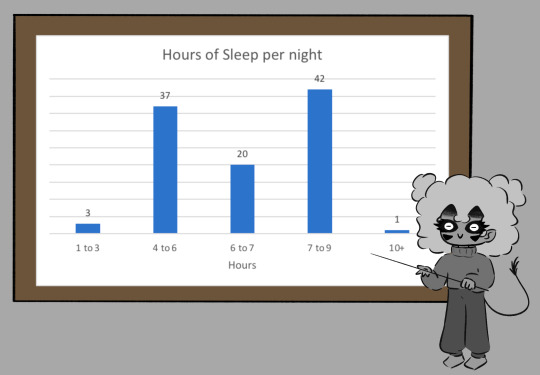
Now that we know how many hours most artist sleep per night, we should take a look at how many hours they consider enough to technically get through the day which is 4,94 hours.
Because the answered had been very specific for most parts I decided to categorize them into full 1 till 9+ hours and steps in between as 1-2; 2-3; 3-4; etc. hours, the most common ones being 4 and 5 hours. Which is kind of close to the average amount they get.
So some could take the wild guess that a lot of people are surviving on their minimum hours per night as daily basis.
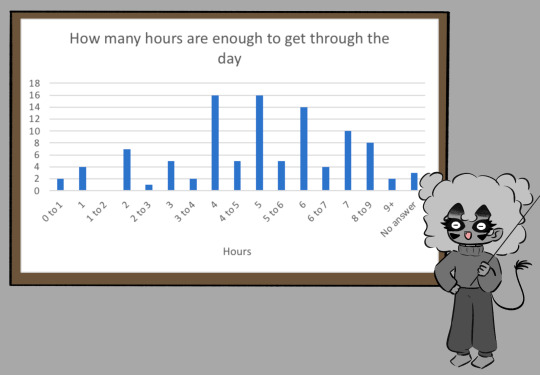
For my next question I could have been more specific with what I meant. My thought behind that question had been, how many hours are a lot in consideration to a not-so-great sleep schedule. For example, a person who usually gets 5-6 hours of sleep could consider getting 7 or 8 hours as a lot.
Some didn’t answer that part which is understandable as the meaning isn’t that clear. I still got a lot of interesting answers! For example, the average “a lot of hours of sleep” value is 9,59 hours.
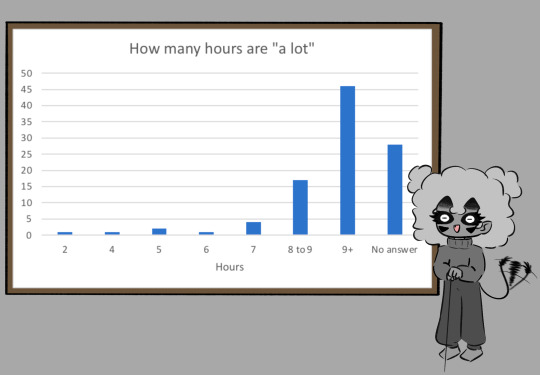
Now let’s get to the caffein!
Surprisingly to me, considering the small average hour per night, 53,85% do not consume any caffein over the day and only 39,42% have it included into their daily routine. The small amount of 6,73% of people use it only as last resort.
On the other hand, after reading all the effects caffein has on most of the people I asked I am not as surprised they´re not consuming it regularly.
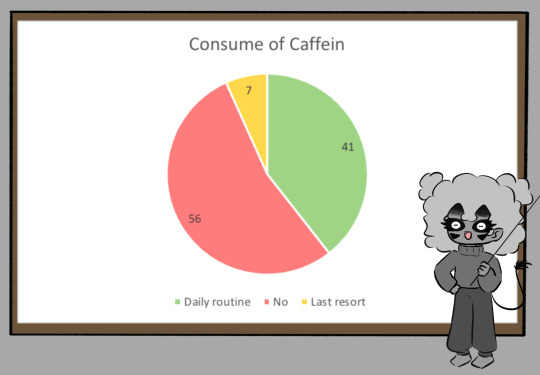
Talking about the different effects of caffein on people please look at the following two pictures where I tried my best to visualize the different answers as good as possible.
In the first one you can see the descriptions how the people are feeling before consuming any caffein. The bigger the word the more often it had been mentioned.
In the second you will see the way they feel after consuming any kind of caffein.
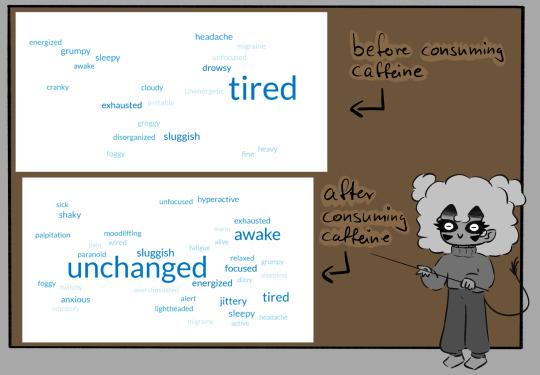
It is pretty prominent that a majority doesn’t feel any different afterwords which could be an explanation why the amount of people drinking caffein is that “small”. But even if the second biggest word is the usual effect caffein has the one directly after that are words like tired, sluggish, jittery which are most definitely affects no one likes to experience.
A lot of the described feelings could be lined to stuff like ADHD or insomnia or anything else where caffein can show a paradox or even negative effect on someone. I have read that a lot of people still like to consume drinks with caffein in it but not because of the effect but more for the taste.
As someone who needs to drink either very strong coffee or energy to actually feel any effect of the caffein, I found it very interesting to see that people mentioned to enjoy drinking tea as little energy boost.
For me tea, or coke or any other caffeinated soda, has such a little amount of caffein in it that I, for myself, didn’t even had it categorized as something that could be used as little caffein booster.
It hadn’t been a question, but I still noted down the kind of drinks people choose to drink as daily caffein source, which actually shows that coffee is the usual to go drink but again, surprisingly lot told me that they don’t drink tea (or anything else) as daily basis but more randomly whenever they feel like it.
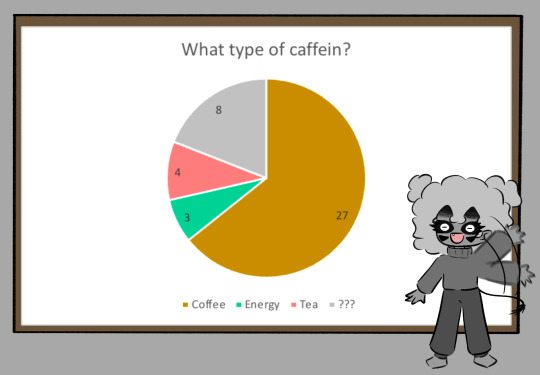
In the end, what can we conclude out of all this messy information?
So, the usual hours you should sleep is put on 7-8 hours per night.
The average hours out of 104 artists in the rottmnt tumblr bubble is 6,48 hours per night with a minimum needed of 4,94 hours to get through the day. The maximum hours got in a night lay by 9,6 hours.
53,85% of these 104 go through their every day without the help of any caffein.
39,42% have caffein included into their daily routine.
6, 73% see caffein only as their last resort and try to avoid consuming any for as long as possible.
Thank you, a lot, for reading so far and thousand thanks to all the people participating in this lil survey again! I had a lot of fun doing this and I hope this little conclusion here is entertaining enough to make it worth having to answer my “few” questions!
If you want to share your own opinion or point out any mistakes I may have made, please feel free to do so~
I wish everyone a happy day and or good night!
If you are interested into my first survey, pls click here :3 Special Thanks to all of the participants!!! @heckitall @triona-tribblescore @butterfilledpockets @crownedcrowrow @pezhead @wraenata @zinovi768 @cokowiii @idiot-mushroom @less-depresso-more-espresso @mightyanxiety @sweeneydino @2aceofspades @mobiitez @onejellyfishplease @titenoute @arrora-art @indieyuugure @tblsomedoodles @theelvishfiddler @tasenwiththerobots @iredoodles @sushixstar @turrondeluxe @signanothername @adorabledrugl0rd @mr-doodles @theastroghost @djpachipikachu @hellishgayliath @frosteaart @godsfaultycreations @koolaidashley @soda-kazoo @tapakah0 @v-albion @sad-leon @angelpuns @sharkfinn @venelona-turtle-den @goatedgreen @graphitehybrid @laseralligator @peach-moths @vangh17a @debb987 @lieutenantbiscute @sunnyyyteaaa @0ransje @manga-toons
#average sleep deprivation survey#Survey#survey about rottmnt tumblr artist#this was lots fun#i love doing these#thx for reading~
276 notes
·
View notes
Text

Misc. Design Notes and Ideas; Piers Nivans

Synchronization Between Prosthesis and Senses
Augmented Reflexes: His bionic arm could have a feedback system connected to his heightened senses, allowing it to respond to auditory or visual cues faster than he can consciously react. For instance, if he hears a sudden change in someone’s heartbeat behind him (indicating they’re approaching or tensing up), his arm could twitch or adjust as if ready to defend or counter.
Haptic Feedback in the Arm: The prosthesis could have sensors that translate environmental data into subtle vibrations or pressure signals, which Piers can feel. For example, in low-light or when he’s using his thermal vision, his arm might subtly vibrate in response to nearby heat sources, giving him a “sixth sense” of people around him without needing to look.
Sensory Overload Thresholds and Control Mechanism
Virus-Triggered Sensory Intensity: When the Virus exerts more control, his senses might intensify to the point where every heartbeat, heat signature, or movement becomes sharply defined and almost overwhelming. This state would enhance his perception but at the cost of mental strain, making it harder for him to focus or maintain rational thought.
Adaptive Mutation in His Arm
Augmented Physical Connection: The prosthetic side of his arm might integrate more closely with the mutating side over time. This would create a unique “fusion” effect where the prosthetic adapts, mirroring changes in the mutation, like absorbing textures or contours that appear on his mutated tissue. This would blur the line between machine and biology even further, reflecting his struggle to retain his humanity.
Predator-Like Instinct Mode
Automatic Threat Detection: If his hearing detects an elevated heartbeat or his eye picks up sudden movement, it could trigger an “instinct mode” where his sensory focus shifts fully onto the target—heightening his reaction time and awareness of that individual’s actions. This would make him hyper-focused on potential threats, though it risks distracting him from other surroundings.
Animalistic Responses to Stress: When the Virus exerts control, Piers’ responses could become more instinctual. For instance, if his mutated eye detects an unexpected heat signature, his body might involuntarily tense, his senses heighten, and his arm adopt a defensive posture. He might also develop reflexes that resemble predatory behavior, like tracking movement without moving his head.

Tags: (Let me know if you’d like to be added or removed!) @astertaster @fonulyn @theyproblyhadsomethingtodowithit @mangoflavouredkisses @mmosscatmoss @essanocollagen @menacing-manicotti @sxnicgoesfast
24 notes
·
View notes
Text
ok I finished season 1 of The Expanse last night. I wasn't supposed to. I was supposed to finish it tonight per my typical 1 episode a night schedule. But what, was I supposed to stop in the middle of Eros??? This show is compulsively watchable. Twice now I've intended on only watching one episode and been unable to stop myself from watching a second. I am holding off a bingewatch through sheer strength of will (and fear of the resulting crash) alone.
It's...different but aside from one thing I genuinely don't like*, it's settling into this state of....but both are good? Like for example: having a perspective on Earth from the jump. On the show's hand, more Avasarala is always a good choice. Loved seeing Montana, and I LOVED the choice to have the UN still in New York, if nothing else for the visual of the Statue of Liberty sticking out of the risen seawaters alone. (Sorry to the Hague, it's just SUCH a good visual.) I think this is setting up Avasarala's character arc starting from a better place, and setting up the web of conspiracies and warmongering we get in Caliban's War.
BUT on the book's hand: I also really liked how Earth's distance and power ended up feeling in the first book. Earth felt like a sleeping giant no one wanted to wake that still affected everyone's daily lives. Its power and influence were present everywhere, but we didn't actually see any direct actions from Earth until they came out so aggressive when they attacked Mars. Like, we see basically nothing of them except the ripple effects of their influence, and then one wrong move by Mars (accusing them of destroying the Cant and the Donnager), and they blow up one of its moons. Without warning. Wham. It made me really understand why they wielded so much power and control, and especially fear in the solar system.
If you asked me to pick which one is 'better' I genuinely don't think I could. They're both narrative choices that work and that is why it's so fun to have both.
*The only thing I genuinely don't like is how mean the crew are to each other! What the hell guys! People prepared me that there's a whole lot of unnecessary added drama so I was braced for it but it still makes me sad, especially when we lose out on lines like this:

And I have some extremely pedantic things like not liking the change to Alex's backstory, the Havelock subplot, that Holden wasn't there when Shed died because that felt like a very formative moment for them as a whole in the book. With that last one, I do understand why, they want to solve the mystery faster. In the books, no one witnesses whatever happens on the Donnager's bridge, so it takes them quite a while of still believing that Mars blew up the Cant to figure out what data they were trying to get off the ship. It makes sense they wanted a main character to witness that AND we got the excellent Lt Lopez scene, he was stellar, so oh no I've landed myself back in 'hmm but both are good' territory.
Still: stop yelling at each other!! they're being so mean! unnecessary!
I also keep flip-flopping on whether reading the books or watching the show first is better. As I said when I was talking about the Mars subversion, I almost want to say show first because I'm so obsessed with how well the production design played with the audience's expectations. If you go into it knowing Mars was being framed, I'm not sure it has quite the same impact, though I'll never know since I cannot, sadly, erase things from my brain to experience them for the first time again. No matter how much I wish I could. But then I watched the episode when they find the Anubis, and watching that knowing the protomolecule feeds on radiation, while the characters don't know that fact yet made things SO tense. The second Amos asks if he should turn on the reactor I was like nooooooo bb don't do it!!! That episode was so stressful.
Anyway, that is the update on my Expanse journey, starting season 2 tonight ✨
8 notes
·
View notes
Text
Headcanons for techfolk vision
Cameras
As we can see from the episodes themselves, Cam vision is very similar to human vision! One way it differs is that when Cams are physically hit or shocked, their vision greys out with scanlines and other artefacts.
You can see a real-life example of this in this video, in which a skydriver drops a video camera and it keeps recording until it lands (in a pig pen!)
youtube
As the camera tumbles, it spins faster than its sensors can keep up with, resulting in the video turning into a series of diagonal lines. Most digital cameras record in a 'sweep', going from one edge or corner to the opposite one. It looks as though this camera records in a diagonal sweep.
This also means that Cameramen possibly don't see things like propellors and hummingbird wings as a blur, as we do - they'd see it as a choppy effect, depending on how the movement syncs with the Cameraman's framerate.
Here's a bird appearing to hover perfectly because its wings happen to match the camera's shutter speed:
youtube
As far as Cameramen are concerned, that's probably just how birds are! They don't see bird wings as a flippa-flappa or propellors as a rounda-rounda blur.
Presumably, Cameramen cannot perceive the chimerical colours, which are colours humans can see thanks to how our retinas form afterimages:
Soundkind
I headcanon that Soundkind primarily perceive the world through echolocation. It's not really possible for humans to grasp what this 'looks' like. We've all heard of Thomas Nagel's essay 'What is it like to be a bat?' But at least a bat is a mammal like us, so it'll have mostly the same neural pathways as us. It's not outside the realms of possibility that bats 'see' the world in the same colours as us, but the colours are triggered in the brain's perception by wavelengths of sound rather than light. But Soundkind aren't even animals! Who knows how a tech brain processes this data?
I also headcanon that the Soundkind can see with light to a degree, just not as well as a human, Cameraman or TVman. Their vision is low-res and is heavy on the reds (hence their use of red as an emblematic colour), similar to a human with tritanomaly.
Here's Tri-Cam, approximately as a human or Cameraman would perceive them (from this SketchFab model):
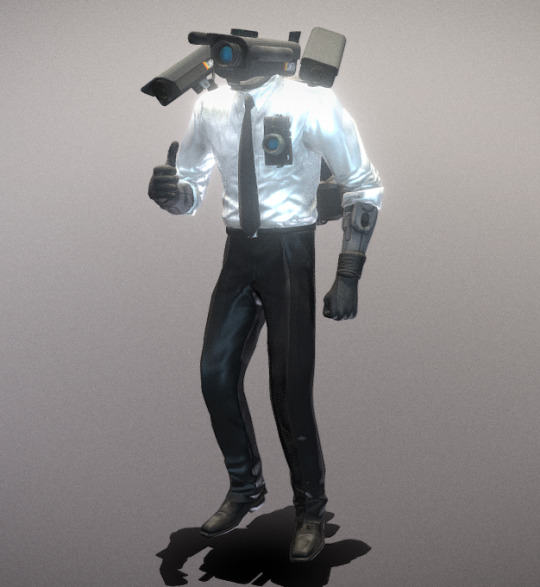
Here's how Soundkind might 'see' Tri-Cam with echolocation. (I took the 'matcap + surface' version of the model to get just the contours without textures, then noodled with it a little in GIMP.)

Here's a scene approximately how a human or Cameraman would perceive it (source):

And how it might look to a Soundkind using their visual processing - mainly red (achieved using a tritanopia simulator), and low resolution:

Here's another 3D model, a bit more colourful than Tri-Cam, as a human or Cameraman might perceive it (source):

Putting together the above info, here's how a Soundkind might perceive it using their echolocation overlaid with their optical vision:

TVs
TVs are primarily optic-based, like humans and Cameras. Their vision overlaps less with the human range than the Cameramen's vision does. TVs see further into the infra-red than humans and Cams (unless said Cams have specialised thermal vision), and their vision has much more of a purple cast, hence their use of purple as an emblematic colour.
TVs can see even in complete darkness (by our standards), because everything above absolute zero gives off IR radiation. However, an environment of absolutely uniform temperature would appear blank, because there would be no differences in IR for the TVman to see. In addition, TVs can't see the temperature of stuff behind glass - they would only see the temperature of the glass itself (same as the limitations for real thermal cameras).
My infra-red headcanon is purely based on the fact that TV remotes are usually IR-based (more modern ones use Bluetooth).
...I don't have a speculative image to show, because to my surprise I couldn't find good quality pictures online of the same scene taken with RGB and with thermal (so I can combine them the way I want them). They were all either postage stamp-sized or they didn't align properly. Hopefully you can imagine something!
This video shows something a bit like what I'm thinking of:
youtube
The video shows that the thermal cam has something called 'MSX', which combines the thermal image with the light image, giving you the thermal imaging info combined with the surface patterns from the light imaging info. However, my headcanon is closer to 'human vision (but a bit more purple) combined with a black-hot greyscale thermal image', as opposed to the purple and yellow mess seen here.
25 notes
·
View notes
Text
The ongoing harms of AI
In the early days of the chatbot hype, OpenAI CEO Sam Altman was making a lot of promises about what large language models (LLMs) would mean for the future of human society. In Altman’s vision, our doctors and teachers would become chatbots and eventually everyone would have their own tailored AI assistant to help with whatever they needed. It wasn’t hard to see what that could mean for people’s jobs, if his predictions were true. The problem for Altman is that those claims were pure fantasy.
Over the 20 months that have passed since, it’s become undeniably clear that LLMs have limitations many companies do not want to acknowledge, as that might torpedo the hype keeping their executives relevant and their corporate valuations sky high. The problem of false information, often deceptively termed “hallucinations,” cannot be effectively tackled and the notion that the technologies will continue getting infinitely better with more and more data has been called into question by the minimal improvements new AI models have been able to deliver.
However, once the AI bubble bursts, that doesn’t mean chatbots and image generators will be relegated to the trash bin of history. Rather, there will be a reassessment of where it makes sense to implement them, and if attention moves on too fast, they may be able to do that with minimal pushback. The challenge visual artists and video game workers are already finding with employers making use of generative AI to worsen the labor conditions in their industries may become entrenched, especially if artists fail in their lawsuits against AI companies for training on their work without permission. But it could be far worse than that.
Microsoft is already partnering with Palantir to feed generative AI into militaries and intelligence agencies, while governments around the world are looking at how they can implement generative AI to reduce the cost of service delivery, often without effective consideration of the potential harms that can come of relying on tools that are well known to output false information. This is a problem Resisting AI author Dan McQuillan has pointed to as a key reason why we must push back against these technologies. There are already countless examples of algorithmic systems have been used to harm welfare recipients, childcare benefit applicants, immigrants, and other vulnerable groups. We risk a repetition, if not an intensification, of those harmful outcomes.
When the AI bubble bursts, investors will lose money, companies will close, and workers will lose jobs. Those developments will be splashed across the front pages of major media organizations and will receive countless hours of public discussion. But it’s those lasting harms that will be harder to immediately recognize, and that could fade as the focus moves on to whatever Silicon Valley places starts pushing as the foundation of its next investment cycle.
All the benefits Altman and his fellow AI boosters promised will fade, just as did the promises of the gig economy, the metaverse, the crypto industry, and countless others. But the harmful uses of the technology will stick around, unless concerted action is taken to stop those use cases from lingering long after the bubble bursts.
36 notes
·
View notes
Text
Subsystems and You 14: Dynamic Hacking

(art by ianllanas on DeviantArt)
A fascinating thing about cyberpunk and near-future scifi in general is how they speculate on what threads technology will go down in the near future.
For example, a lot of cyberpunk fiction speculated that hacking in the future would involve avatars facing off against elaborate 3D representations of security systems and the avatars of counterhackers in what amount to cyber-wizard battles, with things like DDOS attacks, viruses, and the like being visualized in this 3D hacking space as “spells” or special attacks.
You see this sort of thing in anything from Johnny Mnemonic to The Matrix, though in the latter case, the visualization was more the heroes setting up links so that the folks back in the ship could do the real hacking.
Of course, hacking in the real world has never been so fancy-looking or glamorous, and most programming is dedicated to making hacking programs and viruses able to interact with and overwhelm a system rather than making them show a neat picture to represent them doing so. (Not to say they don’t sometimes do that).
But we’re not interested in the real world right now. In the world of Starfinder, which draws inspiration from all over sci-fi, you can absolutely see characters having their own badass avatars and performing elaborate acts of hacking, which is where today’s subject comes in!
To be up front, this subsystem is meant to be used sparingly, as players are not likely to enjoy being bogged down with an elaborate computerized battle every single time they remove a virus or hack a door lock. Indeed, this system is meant to be used more for major hacking jobs. Things like elaborate defenses for campaign-important databases, battles against malevolent AI on their home turf, and so on.
In any case, the dynamic hacking system functionally turns hacking into a form of combat, with rounds and turns and everything.
First, every hacker has a Deceive, Hacking, and Process bonus, which covers the user’s ability to hide their persona from countermeasures, overcome those countermeasures, and perform various other effects separately such as scanning, repairing the persona, and so on.
Each of these three stats use your computer skill by default, but you can set up each with bonuses or penalties before and during a hack to specialize in infiltration, offense, and support, as long as you don’t go over a certain total bonus based on your computer skill.
From there you have the lead hacker, whose persona avatar is on the line, while other support hackers aid them in various ways.
While the support hackers can only perform minor actions, the lead hacker can perform a minor and major action per turn, plus extra if they’re willing to take penalties.
Each dynamic hacking encounter has countermeasures that seek to protect the system, nodes which provide paths to various files and programs, and modules, which represent protected files or programs which the hackers desire access to in order to access their data or function. Each one has their own abilities as well as the DCs to overcome them, the countdowns for any reprisals they offer, and so on.
In order to overcome these obstacles, the hacking team has several actions they can perform, ranging from minor (aiding and assessing) to major (blending in, creating decoys, modifying programs, recalibrating, repairing the persona, and of course, resolving the current obstacle.
Finally, it is also worth noting that this subsystem has rules for incorporating already existing class abilities and other special abilities tied to hacking, allowing them to apply in appropriate ways, such as faster hacking instead reducing the penalty of multiple actions, or countermeasure negation instead giving a massive bonus to resolving them.
As we can see, this style of hacking is not useful for casual hacking actions in normal play, but it can be a fun way to make for a fun and climactic encounter, or even add another layer to a combat encounter, where the party hacker has to crack the code while their allies keep security robots and the like off of them.
Either way, it's also a good reason to come up with your character's persona avatar appearance and other quirks of their hacking style.
That will do for today, but we’ve got one more subject lined up for tomorrow, from Second Edition Pathfinder! (For real this time).
14 notes
·
View notes